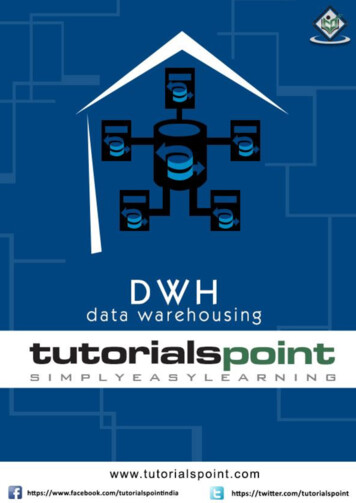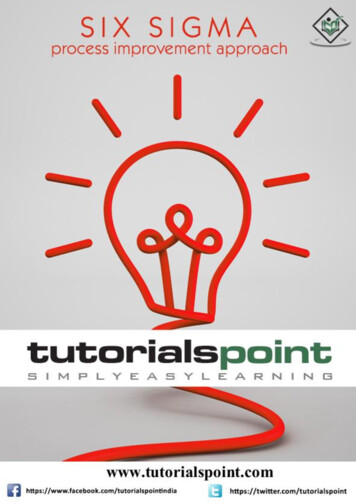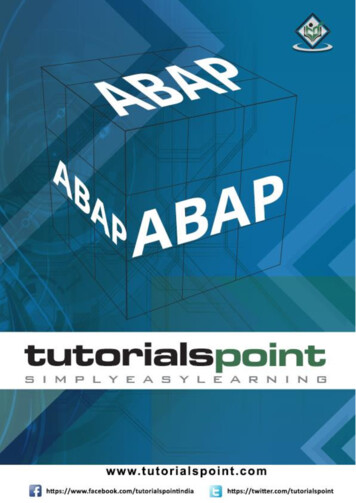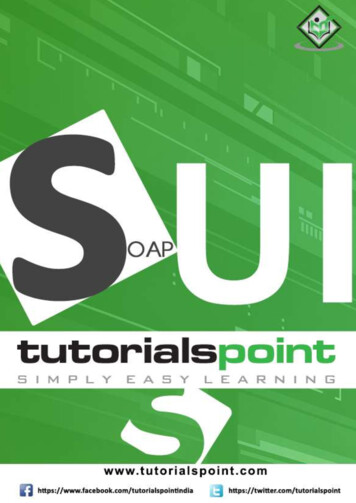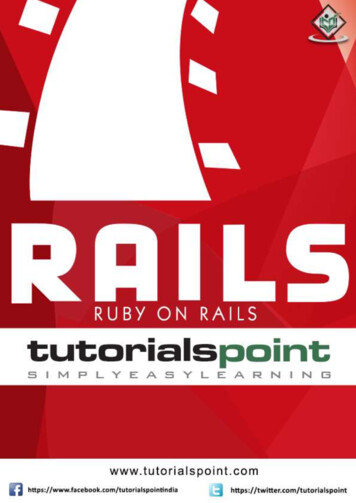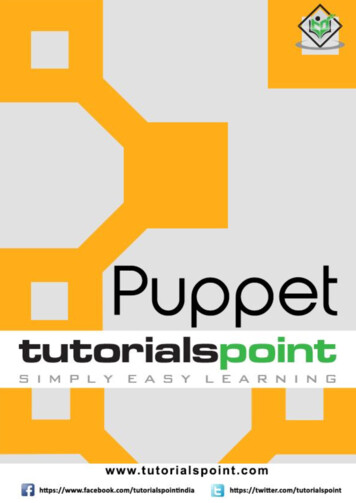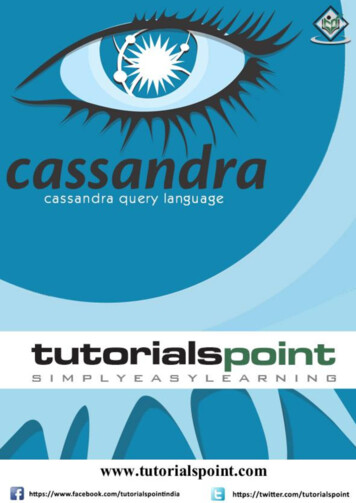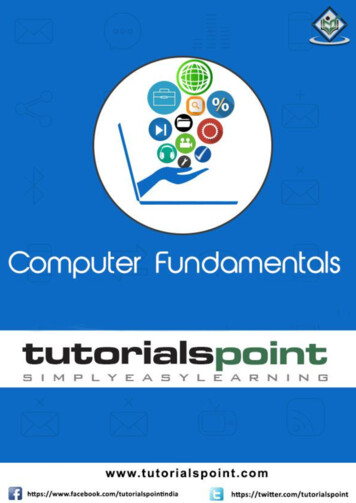
Transcription
About the TutorialComputer is an advanced electronic device that takes raw data as an input from the userand processes it under the control of a set of instructions (called program), produces aresult (output), and saves it for future use.This tutorial explains the foundational concepts of computer hardware, software, operatingsystems, peripherals, etc. along with how to get the most value and impact from computertechnology.AudienceThis tutorial has been prepared for beginners as well as advanced learners who want todeal with computers. The tutorial is also very useful for undergraduate students ofcomputer science, engineering, business administration, management, science, commerceand arts, where an introductory course on computers is a part of curriculum.After completing this tutorial, you will find yourself at a moderate level of expertise in theknowledge of computer basics from where you can take yourself to the next level.PrerequisitesKnowledge of computers is not a prerequisite to follow the contents of this tutorial. Thistutorial assumes no background in Computers or Computer programming.Copyright & Disclaimer Copyright 2017 by Tutorials Point (I) Pvt. Ltd.All the content and graphics published in this e-book are the property of Tutorials Point (I)Pvt. Ltd. The user of this e-book is prohibited to reuse, retain, copy, distribute or republishany contents or a part of contents of this e-book in any manner without written consentof the publisher.We strive to update the contents of our website and tutorials as timely and as precisely aspossible, however, the contents may contain inaccuracies or errors. Tutorials Point (I) Pvt.Ltd. provides no guarantee regarding the accuracy, timeliness or completeness of ourwebsite or its contents including this tutorial. If you discover any errors on our website orin this tutorial, please notify us at contact@tutorialspoint.comi
Table of ContentsAbout the Tutorial . iAudience . iPrerequisites . iCopyright & Disclaimer . iTable of Contents . ii1.COMPUTER FUNDAMENTALS OVERVIEW. 1Functionalities of a Computer . 1Advantages of Computers . 1Disadvantages of Computers . 32.COMPUTER FUNDAMENTALS APPLICATIONS . 43.COMPUTER FUNDAMENTALS GENERATIONS . 8First Generation Computers . 8Second Generation Computers . 10Third Generation Computers . 11Fourth Generation Computers . 12Fifth Generation Computers . 134.COMPUTER FUNDAMENTALS TYPES . 155.COMPUTER FUNDAMENTALS COMPONENTS. 186.COMPUTER FUNDAMENTALS CENTRAL PROCESSING UNIT. 207.COMPUTER FUNDAMENTALS INPUT DEVICES . 22ii
8.COMPUTER FUNDAMENTALS OUTPUT DEVICES . 29Monitors. 29Printers. 309.COMPUTER FUNDAMENTALS MEMORY . 36Cache Memory . 36Primary Memory (Main Memory) . 37Secondary Memory . 3810.COMPUTER FUNDAMENTALS RANDOM ACCESS MEMORY . 39Static RAM (SRAM) . 39Dynamic RAM (DRAM) . 4011.COMPUTER FUNDAMENTALS READ ONLY MEMORY . 4112.COMPUTER FUNDAMENTALS MOTHERBOARD . 4313.COMPUTER FUNDAMENTALS MEMORY UNITS . 4514.COMPUTER FUNDAMENTALS PORTS . 4615.COMPUTER FUNDAMENTALS HARDWARE . 4916.COMPUTER FUNDAMENTALS SOFTWARE . 51System Software . 51Application Software . 5217.COMPUTER FUNDAMENTALS NUMBER SYSTEM . 53Decimal Number System . 53Binary Number System . 54Octal Number System . 54Hexadecimal Number System . 55iii
18.COMPUTER FUNDAMENTALS NUMBER CONVERSION . 56Decimal to Other Base System . 56Other Base System to Decimal System . 57Other Base System to Non-Decimal System . 58Shortcut Method Binary to Octal . 59Shortcut method Octal to Binary . 59Shortcut Method Binary to Hexadecimal . 60Shortcut Method Hexadecimal to Binary . 6019.COMPUTER FUNDAMENTALS DATA AND INFORMATION . 6120.COMPUTER FUNDAMENTALS NETWORKING . 6321.COMPUTER FUNDAMENTALS OPERATING SYSTEM . 6722.COMPUTER FUNDAMENTALS INTERNET AND INTRANET . 6923.COMPUTER FUNDAMENTALS HOW TO BUY A COMPUTER?. 7124.COMPUTER FUNDAMENTALS AVAILABLE COURSES . 74iv
1. Computer Fundamentals OverviewToday’s world is an information-rich world and it has become a necessity for everyone to knowabout computers. A computer is an electronic data processing device, which accepts andstores data input, processes the data input, and generates the output in a required format.The purpose of this tutorial is to introduce you to Computers and its fundamentals.Functionalities of a ComputerIf we look at it in a very broad sense, any digital computer carries out the following fivefunctions:Step 1 - Takes data as input.Step 2 - Stores the data/instructions in its memory and uses them as required.Step 3 - Processes the data and converts it into useful information.Step 4 - Generates the output.Step 5 - Controls all the above four steps.Advantages of ComputersFollowing are certain advantages of computers.High Speed Computer is a very fast device. It is capable of performing calculation of very large amount of data. The computer has units of speed in microsecond, nanosecond, and even thepicosecond.5
It can perform millions of calculations in a few seconds as compared to man who willspend many months to perform the same task.Accuracy In addition to being very fast, computers are very accurate. The calculations are 100% error free. Computers perform all jobs with 100% accuracy provided that the input is correct.Storage Capability Memory is a very important characteristic of computers. A computer has much more storage capacity than human beings. It can store large amount of data. It can store any type of data such as images, videos, text, audio, etc.Diligence Unlike human beings, a computer is free from monotony, tiredness, and lack ofconcentration. It can work continuously without any error and boredom. It can perform repeated tasks with the same speed and accuracy.Versatility A computer is a very versatile machine. A computer is very flexible in performing the jobs to be done. This machine can be used to solve the problems related to various fields. At one instance, it may be solving a complex scientific problem and the very nextmoment it may be playing a card game.Reliability A computer is a reliable machine. Modern electronic components have long lives.6
Computers are designed to make maintenance easy.Automation Computer is an automatic machine. Automation is the ability to perform a given task automatically. Once the computerreceives a program i.e., the program is stored in the computer memory, then theprogram and instruction can control the program execution without human interaction.Reduction in Paper Work and Cost The use of computers for data processing in an organization leads to reduction in paperwork and results in speeding up the process. As data in electronic files can be retrieved as and when required, the problem ofmaintenance of large number of paper files gets reduced. Though the initial investment for installing a computer is high, it substantially reducesthe cost of each of its transaction.Disadvantages of ComputersFollowing are certain disadvantages of computers.No I.Q. A computer is a machine that has no intelligence to perform any task. Each instruction has to be given to the computer. A computer cannot take any decision on its own.Dependency It functions as per the user’s instruction, thus it is fully dependent on humans.Environment The operating environment of the computer should be dust free and suitable.No Feeling Computers have no feelings or emotions. It cannot make judgment based on feeling, taste, experience, and knowledge unlikehumans.7
2. Computer Fundamentals ApplicationsIn this chapter, we will discuss the application of computers in various fields.BusinessA computer has high speed of calculation,diligence, accuracy, reliability, or versatility whichhas made it an integrated part in all businessorganizations.Computer is used in business organizations for: Payroll calculationsBudgetingSales analysisFinancial forecastingManaging employee databaseMaintenance of stocks, etc.BankingToday, banking is almost totally dependent oncomputers.Banks provide the following facilities: Online accounting facility, which includeschecking current balance, makingdeposits and overdrafts, checking interestcharges, shares, and trustee records. ATM machines which are completelyautomated are making it even easier forcustomers to deal with banks.8
InsuranceInsurance companies are keeping all records upto-date with the help of computers. Insurancecompanies, finance houses, and stock brokingfirms are widely using computers for theirconcerns.Insurance companies are maintaining a databaseof all clients with information showing: Procedure to continue with policies Starting date of the policies Next due installment of a policy Maturity date Interests due Survival benefits BonusEducationThe computer helps in providing a lot of facilities in the education system. The computer provides a tool in the education system known as CBE (Computer BasedEducation). CBE involves control,evaluation of learning. Computer education is rapidly increasingthe graph of number of computer students. There are a number of methods in whicheducational institutions can use a computerto educate the students. It is used to prepare a database aboutperformance of a student and analysis is carried out on this basis.delivery,andMarketing9
In marketing, uses of the computer are following: Advertising - With computers, advertisingprofessionals create art and graphics, writeand revise copy, and print and disseminateads with the goal of selling more products. Home Shopping - Home shopping hasbeen made possible through the use ofcomputerized catalogues that provideaccess to product information and permitdirect entry of orders to be filled by thecustomers.HealthcareComputers have become an important part in hospitals, labs, and dispensaries. They arebeing used in hospitals to keep the record of patients and medicines. It is also used in scanningand diagnosing different diseases. ECG, EEG, ultrasounds and CT scans, etc. are also done bycomputerized machines.Following are some major fields of health care in which computers are used. Diagnostic System - Computers are used to collect data and identify the cause ofillness. Lab-diagnostic System - All tests can bedone and the reports are prepared bycomputer. Patient Monitoring System - These areused to check the patient's signs forabnormality such as in Cardiac Arrest, ECG,etc. PharmaInformationSystem- Computer is used to check drug labels,expiry dates, harmful side effects, etc. Surgery - Nowadays, computers are also used in performing surgery.Engineering DesignComputers are widely used for Engineering purpose.One of the major areas is CAD (Computer Aided Design) that provides creation andmodification of images. Some of the fields are:10
Structural Engineering - Requires stressand strain analysis for design of ships,buildings, budgets, airplanes, etc. Industrial Engineering - Computersdeal with design, implementation, andimprovement of integrated systems ofpeople, materials, and equipment. Architectural Engineering - Computershelp in planning towns, designingbuildings, determining a range of buildingson a site using both 2D and 3D drawings.MilitaryComputers are largely used in defence. Moderntanks, missiles, weapons, etc. Military alsoemploys computerized control systems. Somemilitary areas where a computer has been usedare: Missile Control Military Communication Military Operation and Planning Smart WeaponsCommunicationCommunication is a way to convey a message, an idea, a picture, or speech that is receivedand understood clearly and correctly by the personfor whom it is meant. Some main areas in thiscategory are: E-mail Chatting Usenet FTP Telnet Video-conferencing11
GovernmentComputers play an important role in government services. Some major fields in this categoryare: Budgets Sales tax department Income tax department Computation of male/female ratio Computerization of voters lists Computerization of PAN card Weather forecasting12
3. Computer Fundamentals GenerationsGeneration in computer terminology is a change in technology a computer is/was being used.Initially, the generation term was used to distinguish between varying hardware technologies.Nowadays, generation includes both hardware and software, which together make up anentire computer system.There are five computer generations known till date. Each generation has been discussed indetail along with their time period and characteristics. In the following table, approximatedates against each generation has been mentioned, which are normally accepted.Following are the main five generations of computers.Sr.No.1Generation & DescriptionFirst GenerationThe period of first generation: 1946-1959. Vacuum tube based.Second Generation2The period of second generation: 1959-1965. Transistor based.Third Generation3The period of third generation: 1965-1971. Integrated Circuit based.Fourth Generation4The period of fourth generation: 1971-1980. VLSI microprocessor based.Fifth Generation5The period of fifth generation: 1980-onwards. ULSI microprocessor based.First Generation ComputersThe period of first generation was from 1946-1959. The computers of first generation usedvacuum tubes as the basic components for memory and circuitry for CPU (Central ProcessingUnit). These tubes, like electric bulbs, produced a lot of heat and the installations used to fusefrequently. Therefore, they were very expensive and only large organizations were able toafford it.13
In this generation, mainly batch processing operating system was used. Punch cards, papertape, and magnetic tape was used as input and output devices. The computers in thisgeneration used machine code as the programming language.The main features of the first generation are: Vacuum tube technology Unreliable Supported machine language only Very costly Generated a lot of heat Slow input and output devices Huge size Need of AC14
Non-portable Consumed a lot of electricitySome computers of this generation were: ENIAC EDVAC UNIVAC IBM-701 IBM-650Second Generation ComputersThe period of second generation was from 1959-1965. In this generation, transistors wereused that were cheaper, consumed less power, more compact in size, more reliable and fasterthan the first generation machines made of vacuum tubes. In this generation, magnetic coreswere used as the primary memory and magnetic tape and magnetic disks as secondarystorage devices.In this generation, assembly language and high-level programming languages like FORTRAN,COBOL were used. The computers used batch processing and multiprogramming operatingsystem.15
The main features of second generation are: Use of transistors Reliable in comparison to first generation computers Smaller size as compared to first generation computers Generated less heat as compared to first generation computers Consumed less electricity as compared to first generation computers Faster than first generation computers Still very costly AC required Supported machine and assembly languagesSome computers of this generation were: IBM 1620 IBM 7094 CDC 1604 CDC 3600 UNIVAC 1108Third Generation ComputersThe period of third generation was from 1965-1971. The computers of third generation usedIntegrated Circuits (ICs) in place of transistors. A single IC has many transistors, resistors,and capacitors along with the associated circuitry.The IC was invented by Jack Kilby. This development made computers smaller in size, reliable,and efficient. In this generation remote processing, time-sharing, multi-programmingoperating system were used. High-level languages (FORTRAN-II TO IV, COBOL, PASCAL PL/1,BASIC, ALGOL-68 etc.) were used during this generation.16
The main features of third generation are: IC used More reliable in comparison to previous two generations Smaller size Generated less heat Faster Lesser maintenance Costly AC required Consumed lesser electricity Supported high-level languageSome computers of this generation were: IBM-360 series Honeywell-6000 series PDP (Personal Data Processor) IBM-370/168 TDC-316Fourth Generation ComputersThe period of fourth generation was from 1971-1980. Computers of fourth generation usedVery Large Scale Integrated (VLSI) circuits. VLSI circuits having about 5000 transistors and17
other circuit elements with their associated circuits on a single chip made it possible to havemicrocomputers of fourth generation.Fourth generation computers became more powerful, compact, reliable, and affordable. As aresult, it gave rise to Personal Computer (PC) revolution. In this generation, time sharing,real time networks, distributed operating system were used. All the high-level languages likeC, C , DBASE etc., were used in this generation.The main features of fourth generation are: VLSI technology used Very cheap Portable and reliable Use of PCs Very small size Pipeline processing No AC required Concept of internet was introduced Great developments in the fields of networks Computers became easily availableSome computers of this generation were: DEC 1018
STAR 1000 PDP 11 CRAY-1(Super Computer) CRAY-X-MP(Super Computer)Fifth Generation ComputersThe period of fifth generation is 1980-till date. In the fifth generation, VLSI technology becameULSI (Ultra Large Scale Integration) technology, resulting in the production of microprocessorchips having ten million electronic components.This generation is based on parallel processing hardware and AI (Artificial Intelligence)software. AI is an emerging branch in computer science, which interprets the means andmethod of making computers think like human beings. All the high-level languages like C andC , Java, .Net etc., are used in this generation.AI includes: Robotics Neural Networks Game Playing Development of expert systems to make decisions in real-life situations Natural language understanding and generationThe main features of fifth generation are:19
ULSI technology Development of true artificial intelligence Development of Natural language processing Advancement in Parallel Processing Advancement in Superconductor technology More user-friendly interfaces with multimedia features Availability of very powerful and compact computers at cheaper ratesSome computer types of this generation are: Desktop Laptop NoteBook UltraBook ChromeBook20
4. Computer Fundamentals TypesComputers can be broadly classified by their speed and computing power.Sr.No.TypeSpecifications1PC (PersonalComputer)It is a single user computer system having moderatelypowerful microprocessor2WorkstationIt is also a single user computer system, similar to personalcomputer however has a more powerful microprocessor3Mini ComputerIt is a multi-user computer system, capable of supportinghundreds of users simultaneously.4Main FrameIt is a multi-user computer system, capable of supportinghundreds of users simultaneously. Software technology isdifferent from minicomputer.5SupercomputerIt is an extremely fast computer, which can executehundreds of millions of instructions per second.PC (Personal Computer)A PC can be defined as a small, relatively inexpensive computer designed for an individualuser. PCs are based on the microprocessor technology that enables manufacturers to put anentire CPU on one chip. Businesses use personalcomputers for word processing, accounting,desktop publishing, and for running spreadsheetand database management applications. At home,the most popular use for personal computers isplaying games and surfing the Internet.Although personal computers are designed assingle-user systems, these systems are normallylinked together to form a network. In terms ofpower, now-a-days high-end models of theMacintosh and PC offer the same computing powerand graphics capability as low-end workstations bySun Microsystems, Hewlett-Packard, and Dell.21
WorkstationWorkstation is a computer used for engineering applications (CAD/CAM), desktop publishing,software development, and other such types of applications which require a moderate amountof computing power and relatively high quality graphics capabilities.Workstations generally come with a large, high-resolution graphics screen, large amount ofRAM, inbuilt network support, and a graphical userinterface. Most workstations also have massstorage device such as a disk drive, but a specialtype of workstation, called diskless workstation,comes without a disk drive.Common operating systems for workstations areUNIX and Windows NT. Like PC, workstations arealso single-user computers like PC but are typicallylinked together to form a local-area network,although they can also be used as stand-alonesystems.MinicomputerIt is a midsize multi-processing system capable of supporting up to 250 users simultaneously.MainframeMainframe is very large in size and is an expensive computer capable of supporting hundredsor even thousands of users simultaneously. Mainframe executes many programs concurrentlyand supports many simultaneous execution of programs.22
SupercomputerSupercomputers are one of the fastest computers currently available. Supercomputers arevery expensive and are employed for specialized applications that require immense amountof mathematical calculations (number crunching).For example, weather forecasting, scientific simulations, (animated) graphics, fluid dynamiccalculations, nuclear energy research, electronic design, and analysis of geological data (e.g.in petrochemical prospecting).23
5. Computer Fundamentals ComponentsAll types of computers follow the same basic logical structure and perform the following fivebasic operations for converting raw input data into information useful to their users.Sr. No.OperationDescription1Take InputThe process of entering data and instructions into thecomputer system.2Store DataSaving data and instructions so that they are available forprocessing as and when required.3Processing DataPerforming arithmetic, and logical operations on data inorder to convert them into useful information.4OutputInformationThe process of producing useful information or results forthe user, such as a printed report or visual display.5Control theworkflowDirects the manner and sequence in which all of the aboveoperations are performed.Input Unit24
This unit contains devices with the help of which we enter data into the computer. This unitcreates a link between the user and the computer. The input devices translate the informationinto a form understandable by the computer.CPU (Central Processing Unit)CPU is considered as the brain of the computer. CPU performs all types of data processingoperations. It stores data, intermediate results, and instructions (program). It controls theoperation of all parts of the computer.CPU itself has the following three components: ALU (Arithmetic Logic Unit) Memory Unit Control UnitOutput UnitThe output unit consists of devices with the help of which we get the information from thecomputer. This unit is a link between the computer and the users. Output devices translatethe computer's output into a form understandable by the users.25
End of ebook previewIf you liked what you saw Buy it from our store @ https://store.tutorialspoint.com26
Computer is an advanced electronic device that takes raw data as an input from the user and processes it under the control of a set of instructions (called program), produces a result (output), and saves it for future use. This tutorial explains the foundational concepts o


